springboot启动原理分析
文章目录
-
- 一、 前言
- 二、 @SpringBootApplication原理解析
-
-
- 1. @SpringBootApplication组合注解剖析
- 2. @SpringBootConfiguration
- 3. @ComponentScan
- 4. @EnableAutoConfiguration
-
- 三、 SpringApplication.run()原理解析
-
-
- 1. 创建SpringApplicaiton
-
-
- 1.1 获取应用类型
- 1.2 获取初始化器
- 1.3 获取初监听器
- 1.4 定位main方法
-
- 2. 调用run方法
-
-
- 2.1 run方法代码总览
- 2.2 监听器
- 2.3 引入注解
- 2.4内置tomcat
-
-
- 三. springboot总结
-
-
- 3.1 springboot原理
- 3.2 springboot启动流程
-
一、 前言
我们启动一个springboot项目,最简单的就是配置一个springboot启动类,然后运行即可
@SpringBootApplication
public class SpringBoot {
public static void main(String[] args) {
SpringApplication.run(SpringBoot.class, args);
}
}
通过上面的代码,我们可以看出springboot启动的关键主要有两个地方,第一个就是@SpringBootApplication注解,第二个就是 SpringApplication.run(SpringBoot.class, args);这个方法,那么他们内部究竟是如何运作的呢?
二、 @SpringBootApplication原理解析
1. @SpringBootApplication组合注解剖析
首先,我们直接追踪@SpringBootApplication的源码,可以看到其实@SpringBootApplication是一个组合注解,他分别是由底下这些注解组成。
@Target(ElementType.TYPE)
@Retention(RetentionPolicy.RUNTIME)
@Documented
@Inherited
@SpringBootConfiguration
@EnableAutoConfiguration
@ComponentScan(excludeFilters = { @Filter(type = FilterType.CUSTOM, classes = TypeExcludeFilter.class),
@Filter(type = FilterType.CUSTOM, classes = AutoConfigurationExcludeFilter.class) })
这些注解虽然看起来很多,但是除去元注解,真正起作用的注解只有以下三个注解:
@SpringBootConfiguration
@EnableAutoConfiguration
@ComponentScan
那这三个注解是有啥用?其实在Spring Boot 1.2版之前,或者我们初学者刚开始接触springboot时,都还没开始使用@SpringBootApplication这个注解,而是使用以上三个注解启动项目。如果有兴趣的,也可以手动敲敲代码,就会发现这样也可以正常启动项目!
@SpringBootConfiguration
@EnableAutoConfiguration
@ComponentScan
public class SpringBoot {
public static void main(String[] args) {
SpringApplication.run(SpringBoot.class, args);
}
}
所以说这三个注解才是背后的大佬,@SpringBootApplication只是个空壳子。接下来,我来说明下这三个注解各自的作用。
2. @SpringBootConfiguration
同样,我们跟踪下@SpringBootConfiguration的源代码,看下他由哪些注解组成
@Target(ElementType.TYPE)
@Retention(RetentionPolicy.RUNTIME)
@Documented
@Configuration
可以看到,除去元注解,剩下的@Configuration注解我相信大家应该都很熟了!我们springboot为什么可以去除xml配置,靠的就是@Configuration这个注解。所以,它的作用就是将当前类申明为配置类,同时还可以使用@bean注解将类以方法的形式实例化到spring容器,而方法名就是实例名,看下代码你就懂了!
@Configuration
public class TokenAutoConfiguration {
@Bean
public TokenService tokenService() {
return new TokenService();
}
}
作用等同于xml配置文件的
3. @ComponentScan
我们先说下@ComponentScan作用。他的作用就是扫描当前包以及子包,将有@Component,@Controller,@Service,@Repository等注解的类注册到容器中,以便调用。
注:大家第一眼见到@ComponentScan这个注解的时候是否有点眼熟?之前,一些传统框架用xml配置文件配置的时候,一般都会使用
@Configuration
@ComponentScan(basePackages="XXX")
public class SpringBoot {
}
注:如果@ComponentScan不指定basePackages,那么默认扫描当前包以及其子包,而@SpringBootApplication里的@ComponentScan就是默认扫描,所以我们一般都是把springboot启动类放在最外层,以便扫描所有的类。
4. @EnableAutoConfiguration
这里先总结下@EnableAutoConfiguration的工作原理,大家后面看的应该会更清晰:
它主要就是通过内部的方法,扫描classpath的META-INF/spring.factories配置文件(key-value),将其中的
org.springframework.boot.autoconfigure.EnableAutoConfiguration 对应的配置项实例化并且注册到spring容器。
ok,我们同样打开@EnableAutoConfiguration源码,可以发现他是由以下几个注解组成的
@Target(ElementType.TYPE)
@Retention(RetentionPolicy.RUNTIME)
@Documented
@Inherited
@AutoConfigurationPackage
@Import(AutoConfigurationImportSelector.class)
除去元注解,主要注解就是@AutoConfigurationPackage和@Import(AutoConfigurationImportSelector.class)
我们springboot项目为什么可以自动载入应用程序所需的bean?就是因为这个神奇的注解@Import。那么这个@Import怎么这么牛皮?没关系!我们一步一步的看下去!
首先我们先进入AutoConfigurationImportSelector类,可以看到他有一个方法selectImports(),
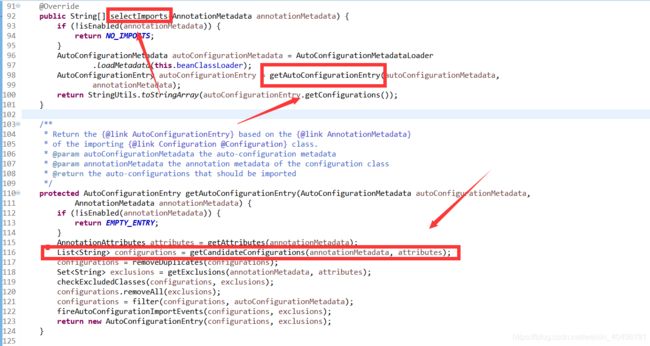
继续跟踪,进入getAutoConfigurationEntry()方法
List configurations = getCandidateConfigurations(annotationMetadata, attributes);
可以看到这里有个List集合,那这个List集合又是干嘛的?没事,我们继续跟踪getCandidateConfigurations()方法!

可以看到这里有个方法
SpringFactoriesLoader.loadFactoryNames(getSpringFactoriesLoaderFactoryClass(),getBeanClassLoader());
这个方法的作用就是读取classpath下的META-INF/spring.factories文件的配置,将key为 org.springframework.boot.autoconfigure.EnableAutoConfiguration 对应的配置项读取出来,通过反射机制实例化为配置文件,然后注入spring容器。
注:假如你想要实例化一堆bean,可以通过配置文件先将这些bean实例化到容器,等其他项目调用时,在spring.factories中写入这个配置文件的路径即可!我前面的文章有这个例子https://blog.csdn.net/weixin_40496191/article/details/109065430
主要是实现自己创建的starter依赖包,然后由其他项目引入使用,这是我的spring.factories文件
org.springframework.boot.autoconfigure.EnableAutoConfiguration=zzk.config.TokenAutoConfiguration
然后直接在SpringFactoriesLoader.loadFactoryNames;这个方法后面打个断点,可以在返回的集合里找到我们自定义的配置文件路径!
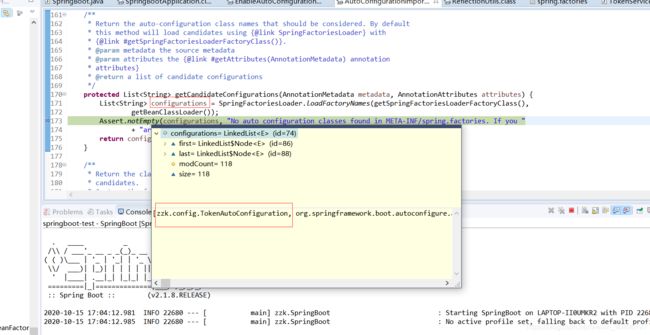
说明成功引入我们自定义的依赖包!
三、 SpringApplication.run()原理解析
SpringApplication.run()原理相对于前面注解的原理,会稍微麻烦点,为了方便我会适当贴出一些注解代码。
首先我们点击查看run方法的源码


可以看出,其实SpringApplication.run()包括两个部分,一部分就是创建SpringApplicaiton实例,另一部分就是调用run()方法,那他们又是怎么运行的?
1. 创建SpringApplicaiton
继续跟踪SpringApplication实例的源码

继续跟踪进入,到如下这个方法中
@SuppressWarnings({ "unchecked", "rawtypes" })
public SpringApplication(ResourceLoader resourceLoader, Class... primarySources) {
this.resourceLoader = resourceLoader;
Assert.notNull(primarySources, "PrimarySources must not be null");
this.primarySources = new LinkedHashSet<>(Arrays.asList(primarySources));
//获取应用类型
this.webApplicationType = WebApplicationType.deduceFromClasspath();
//获取所有初始化器
setInitializers((Collection) getSpringFactoriesInstances(ApplicationContextInitializer.class));
//获取所有监听器
setListeners((Collection) getSpringFactoriesInstances(ApplicationListener.class));
//定位main方法
this.mainApplicationClass = deduceMainApplicationClass();
}
springboot在创建SpringApplicaiton实例的时候,主要是做了以上四个事情,ok,继续拆分一一讲解!
1.1 获取应用类型
跟踪deduceFromClasspath方法

从返回结果我们可以看出应用类型一共有三种,分别是
NONE: 非web应用,即不会启动服务器
SERVLET: 基于servlet的web应用
REACTIVE: 响应式web应用(暂未接触过)
判断一共涉及四个常量:
WEBFLUX_INDICATOR_CLASS
WEBMVC_INDICATOR_CLASS
JERSEY_INDICATOR_CLASS
SERVLET_INDICATOR_CLASSES
springboot在初始化容器的时候,会对以上四个常量所对应的class进行判断,看看他们是否存在,从而返回应用类型!至于常量代表哪些class,大家可以自己跟踪看看,也在当前类中!
1.2 获取初始化器
跟踪进入getSpringFactoriesInstances方法
private Collection getSpringFactoriesInstances(Class type) {
return getSpringFactoriesInstances(type, new Class[] {});
}
private Collection getSpringFactoriesInstances(Class type, Class[] parameterTypes, Object... args) {
ClassLoader classLoader = getClassLoader();
// Use names and ensure unique to protect against duplicates
//获取所有初始化器的名称集合
Set names = new LinkedHashSet<>(SpringFactoriesLoader.loadFactoryNames(type, classLoader));
//根据名称集合实例化这些初始化器
List instances = createSpringFactoriesInstances(type, parameterTypes, classLoader, args, names);
//排序
AnnotationAwareOrderComparator.sort(instances);
return instances;
}
从代码可以看出是在META-INF/spring.factories配置文件里获取初始化器,然后实例化、排序后再设置到initializers属性中。
1.3 获取初监听器
同样跟踪源码,发现其实监听器和初始化的操作是基本一样的
private Collection getSpringFactoriesInstances(Class type) {
return getSpringFactoriesInstances(type, new Class[] {});
}
private Collection getSpringFactoriesInstances(Class type, Class[] parameterTypes, Object... args) {
ClassLoader classLoader = getClassLoader();
// Use names and ensure unique to protect against duplicates
Set names = new LinkedHashSet<>(SpringFactoriesLoader.loadFactoryNames(type, classLoader));
List instances = createSpringFactoriesInstances(type, parameterTypes, classLoader, args, names);
AnnotationAwareOrderComparator.sort(instances);
return instances;
}
这里就不多做解释了!
1.4 定位main方法
跟踪源码进入deduceMainApplicationClass方法
private Class deduceMainApplicationClass() {
try {
//通过创建运行时异常的方式获取栈
StackTraceElement[] stackTrace = new RuntimeException().getStackTrace();
//遍历获取main方法所在的类并且返回
for (StackTraceElement stackTraceElement : stackTrace) {
if ("main".equals(stackTraceElement.getMethodName())) {
return Class.forName(stackTraceElement.getClassName());
}
}
}
catch (ClassNotFoundException ex) {
// Swallow and continue
}
return null;
}
2. 调用run方法
2.1 run方法代码总览
// 开启计时类进行计时
StopWatch stopWatch = new StopWatch();
stopWatch.start();
//声明应用上下文
ConfigurableApplicationContext context = null;
// 记录sprongboot启动异常日志
Collection exceptionReporters = new ArrayList<>();
//设置系统java.awt.headless属性,默认为true(跟踪代码可以看到)
configureHeadlessProperty();
// 获取监听器,它的作用是为后期一些环境参数进行赋值,就是加载配置文件
// 获取到org.springframework.boot.context.event.EventPublishingRunListener
// implements SpringApplicationRunListener
SpringApplicationRunListeners listeners = getRunListeners(args);
//********* 遍历调用监听器,表示监听器已经开始初始化容器**********
listeners.starting();
try {
// 将args包装厂ApplicationArguments类
ApplicationArguments applicationArguments = new DefaultApplicationArguments(args);
// ********监听器开始对对环境参数进行赋值***********
ConfigurableEnvironment environment = prepareEnvironment(listeners, applicationArguments);
configureIgnoreBeanInfo(environment);
//打印banner图,就是我们springboot启动时,前面几行图形
Banner printedBanner = printBanner(environment);
// 初始化上下文对象AnnotationConfigServletWebServerApplicationContext
context = createApplicationContext();
// 异常采集
exceptionReporters = getSpringFactoriesInstances(SpringBootExceptionReporter.class,
new Class[] { ConfigurableApplicationContext.class }, context);
// 部署上下文
prepareContext(context, environment, listeners, applicationArguments, printedBanner);
// springbootApplication生效
// 刷新上下文
refreshContext(context);
//刷新后的方法,空方法,给用户自定义重写
afterRefresh(context, applicationArguments);
//结束计时
stopWatch.stop();
//输出日志记录执行主类名、时间信息
if (this.logStartupInfo) {
new StartupInfoLogger(this.mainApplicationClass).logStarted(getApplicationLog(), stopWatch);
}
//********* 使用广播和回调机制告诉监听者springboot容器已经启动化成功**********
listeners.started(context);
//做一些调整顺序操作
callRunners(context, applicationArguments);
} catch (Throwable ex) {
handleRunFailure(context, ex, exceptionReporters, listeners);
throw new IllegalStateException(ex);
}
try {
//********* 使用广播和回调机制告诉已经可以运行springboot了**********
listeners.running(context);
} catch (Throwable ex) {
handleRunFailure(context, ex, exceptionReporters, null);
throw new IllegalStateException(ex);
}
//返回上下文
return context;
2.2 监听器
1.跟踪监听器==>EventPublishingRunListener
run方法代码总览在这里面,listeners出现了很多次,调用了start,running等方法。这时候你可能会问,那他们又有什么区别呢?首先,我们先跟踪源码看看这个listeners到底是什么玩意儿…
我们进入getRunListeners方法,可以看到
private SpringApplicationRunListeners getRunListeners(String[] args) {
Class[] types = new Class[] { SpringApplication.class, String[].class };
return new SpringApplicationRunListeners(logger,
getSpringFactoriesInstances(SpringApplicationRunListener.class, types, this, args));
}
getSpringFactoriesInstances方法大家看了前面的现在应该知道了,这段代码的意思就是要去所有的META-INF文件下的spring.factorie寻找关于key为SpringApplicationRunListener的value配置,ok,那我们找找,可以发现在这里存在

看样子这个方法最后返回的是org.springframework.boot.context.event.EventPublishingRunListener这个类,那我们就打开这个类看看是啥。

这个方法它实现了SpringApplicationRunListener接口,那么,这个接口是干啥的呢?没错,他就是用来加载我们配置文件用的。接下来我弄个简单的例子,大家就知道怎么用了。
2.EventPublishingRunListener接口举例
主要实现自定义监听器并且读取我们配置文件内容,先献上我的文件结构
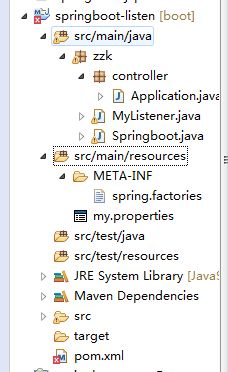
创建一个maven项目,pom配置只需要添加web依赖即可
org.springframework.boot
spring-boot-starter-parent
2.1.8.RELEASE
org.springframework.boot
spring-boot-starter-web
在resource自定义配置文件my.properties
tzr.name=zzk
自定义监听器,这里主要是对starting、environmentPrepared、started、running方法进行实现
package zzk;
import java.io.IOException;
import java.util.Properties;
import org.springframework.boot.SpringApplication;
import org.springframework.boot.SpringApplicationRunListener;
import org.springframework.context.ConfigurableApplicationContext;
import org.springframework.core.Ordered;
import org.springframework.core.env.ConfigurableEnvironment;
import org.springframework.core.env.MutablePropertySources;
import org.springframework.core.env.PropertiesPropertySource;
import org.springframework.core.env.PropertySource;
/**
* 集成监听器加载我们的配置文件
* @author zhanzhk
*
*/
public class MyListener implements SpringApplicationRunListener,Ordered {
private SpringApplication application;
private String[] args;
@Override
public void starting() {
System.out.println("表示准备开始使用监听器");
}
public MyListener(SpringApplication application, String[] args) {
this.application = application;
this.args = args;
}
@Override
public void environmentPrepared(ConfigurableEnvironment environment) {
System.out.println("表示已经开始读取配置文件");
//配置文件到程序,再然后放入springboot容器
Properties properties=new Properties();
try {
//读取properties容器
properties.load(this.getClass().getClassLoader().getResourceAsStream("my.properties"));
//读取名字为my
PropertySource propertySource=new PropertiesPropertySource("my",properties) ;
//加载资源到springboot容器
MutablePropertySources propertySources=environment.getPropertySources();
propertySources.addLast(propertySource);
//换种思路,如果你配置文件是放在网络上,可以直接读取放入我们的项目中
} catch (IOException e) {
System.out.println("出错");
}
}
@Override
public void contextPrepared(ConfigurableApplicationContext context) {
// TODO Auto-generated method stub
}
@Override
public void contextLoaded(ConfigurableApplicationContext context) {
// TODO Auto-generated method stub
}
@Override
public void started(ConfigurableApplicationContext context) {
System.out.println("表示初始化容器已经结束");
}
@Override
public void running(ConfigurableApplicationContext context) {
System.out.println("表示可以使用springboot了");
}
@Override
public void failed(ConfigurableApplicationContext context, Throwable exception) {
// TODO Auto-generated method stub
}
//读取优先级
@Override
public int getOrder() {
// TODO Auto-generated method stub
return -1;
}
}
然后编写controller文件对我们的配置参数进行调用
package zzk.controller;
import org.springframework.beans.factory.annotation.Value;
import org.springframework.stereotype.Controller;
import org.springframework.web.bind.annotation.RequestMapping;
import org.springframework.web.bind.annotation.ResponseBody;
@Controller
public class Application {
@Value("${tzr.name}")
private String name;
@RequestMapping("test")
@ResponseBody
public String test() {
String x = name;
return x;
}
}
ok,那我们自定义的监听器springboot程序又是如何获取的?前面我们代码里讲过了,它主要是读取META-INF底下的spring.factories文件,然后获取监听器,ok那就简单了,我们直接照着EventPublishingRunListener一样在resource增加METAA_INF/spring.factories文件
org.springframework.boot.SpringApplicationRunListener=\
zzk.MyListener
最后设置spring启动器
package zzk;
import org.springframework.boot.SpringApplication;
import org.springframework.boot.autoconfigure.SpringBootApplication;
@SpringBootApplication
public class Springboot {
public static void main(String[] args) {
SpringApplication.run(Springboot.class, args);
}
}
启动!可以看到启动信息
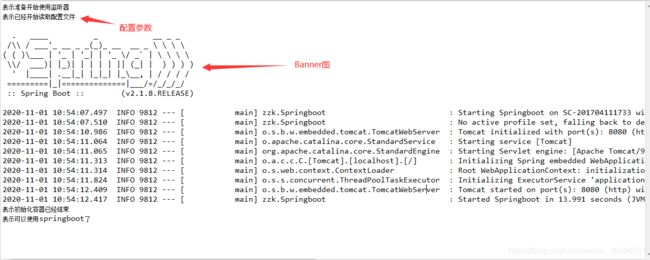
然后我们再调用controller方法

成功读取我们自定义的配置文件,现在再回头看看run方法,是不是就清晰了!
2.3 引入注解
springboot的启动分为两部分,一部分是注解,一部分是SpringApplication.run(Springboot.class, args),那么我们的注解又是如何嵌入到程序中呢?靠的就是refreshContext方法,同理,我们跟踪源码进入refreshContext方法
@Override
public void refresh() throws BeansException, IllegalStateException {
synchronized (this.startupShutdownMonitor) {
// 准备这个上下文来刷新。
prepareRefresh();
// 告诉子类刷新内部bean工厂。
ConfigurableListableBeanFactory beanFactory = obtainFreshBeanFactory();
// 准备bean在此上下文中使用。
prepareBeanFactory(beanFactory);
try {
// 允许在上下文子类中对bean工厂进行后处理。
postProcessBeanFactory(beanFactory);
// 调用在上下文中注册为bean的工厂处理器。
invokeBeanFactoryPostProcessors(beanFactory);
// 注册拦截bean创建的bean处理器。
registerBeanPostProcessors(beanFactory);
// 初始化此上下文的消息源。
initMessageSource();
// 为此上下文初始化事件多播。
initApplicationEventMulticaster();
// 在特定的上下文子类中初始化其他特殊bean。
onRefresh();
// 检查侦听器bean并注册它们。
registerListeners();
// 实例化所有剩余的(非拉齐-init)单例。
finishBeanFactoryInitialization(beanFactory);
// 最后一步:发布相应事件.
finishRefresh();
}
catch (BeansException ex) {
if (logger.isWarnEnabled()) {
logger.warn("Exception encountered during context initialization - " +
"cancelling refresh attempt: " + ex);
}
// 销毁已经创建的单例以避免悬空资源。
destroyBeans();
// 重置“actiove”标志。
cancelRefresh(ex);
// 向调用者传播异常。
throw ex;
}
finally {
// 重置Spring核心中常见的内省缓存,因为我们可能不再需要单例bean的元数据了。。。
resetCommonCaches();
}
}
}
到这里,就可以看到一系列bean的操作,继续跟踪进入invokeBeanFactoryPostProcessors(调用在上下文中注册为bean的工厂处理器)方法



进入ConfigurationClassParser这个类后,方法调用也是挺绕的,这里就不深究了…进入这个类主要是想看下它的一些方法,因为对于springboot注解的引用就是在这个类进行的,比如doProcessConfigurationClass:
@Nullable
protected final SourceClass doProcessConfigurationClass(ConfigurationClass configClass, SourceClass sourceClass)
throws IOException {
if (configClass.getMetadata().isAnnotated(Component.class.getName())) {
// Recursively process any member (nested) classes first
processMemberClasses(configClass, sourceClass);
}
//处理 @PropertySource 注解
for (AnnotationAttributes propertySource : AnnotationConfigUtils.attributesForRepeatable(
sourceClass.getMetadata(), PropertySources.class,
org.springframework.context.annotation.PropertySource.class)) {
if (this.environment instanceof ConfigurableEnvironment) {
processPropertySource(propertySource);
}
else {
logger.info("Ignoring @PropertySource annotation on [" + sourceClass.getMetadata().getClassName() +
"]. Reason: Environment must implement ConfigurableEnvironment");
}
}
// 处理 @ComponentScan 注解
Set componentScans = AnnotationConfigUtils.attributesForRepeatable(
sourceClass.getMetadata(), ComponentScans.class, ComponentScan.class);
if (!componentScans.isEmpty() &&
!this.conditionEvaluator.shouldSkip(sourceClass.getMetadata(), ConfigurationPhase.REGISTER_BEAN)) {
for (AnnotationAttributes componentScan : componentScans) {
// The config class is annotated with @ComponentScan -> perform the scan immediately
Set scannedBeanDefinitions =
this.componentScanParser.parse(componentScan, sourceClass.getMetadata().getClassName());
// Check the set of scanned definitions for any further config classes and parse recursively if needed
for (BeanDefinitionHolder holder : scannedBeanDefinitions) {
BeanDefinition bdCand = holder.getBeanDefinition().getOriginatingBeanDefinition();
if (bdCand == null) {
bdCand = holder.getBeanDefinition();
}
if (ConfigurationClassUtils.checkConfigurationClassCandidate(bdCand, this.metadataReaderFactory)) {
parse(bdCand.getBeanClassName(), holder.getBeanName());
}
}
}
}
//处理 @Import 注解
processImports(configClass, sourceClass, getImports(sourceClass), true);
//处理 @ImportResource 注解
AnnotationAttributes importResource =
AnnotationConfigUtils.attributesFor(sourceClass.getMetadata(), ImportResource.class);
if (importResource != null) {
String[] resources = importResource.getStringArray("locations");
Class readerClass = importResource.getClass("reader");
for (String resource : resources) {
String resolvedResource = this.environment.resolveRequiredPlaceholders(resource);
configClass.addImportedResource(resolvedResource, readerClass);
}
}
//处理 @Bean 注解
Set beanMethods = retrieveBeanMethodMetadata(sourceClass);
for (MethodMetadata methodMetadata : beanMethods) {
configClass.addBeanMethod(new BeanMethod(methodMetadata, configClass));
}
// Process default methods on interfaces
processInterfaces(configClass, sourceClass);
// Process superclass, if any
if (sourceClass.getMetadata().hasSuperClass()) {
String superclass = sourceClass.getMetadata().getSuperClassName();
if (superclass != null && !superclass.startsWith("java") &&
!this.knownSuperclasses.containsKey(superclass)) {
this.knownSuperclasses.put(superclass, configClass);
// Superclass found, return its annotation metadata and recurse
return sourceClass.getSuperClass();
}
}
// No superclass -> processing is complete
return null;
}
ok,过…下一个
2.4内置tomcat
其实,内置tomcat应该要归在refreshContext讲的,因为tomcat就是在注解引入的类中生成的,而refreshContext可以引入注解。不过为了更清楚,这里分开吧。前面说了,我们refreshContext是刷新上下文,那如果想要知道上下文中是否存在生成tomcat的类,我们直接去最后返回的上下文中找对应的类即可!
ok,我们在main方法写获取上下文的代码,并且打印出对应的name
package zzk;
import org.springframework.boot.SpringApplication;
import org.springframework.boot.autoconfigure.SpringBootApplication;
import org.springframework.context.ConfigurableApplicationContext;
@SpringBootApplication
public class Springboot {
public static void main(String[] args) {
ConfigurableApplicationContext configurableApplicationContext = SpringApplication.run(Springboot.class, args);
String[] xs = configurableApplicationContext.getBeanDefinitionNames();
for (String x : xs) {
System.out.println(x);
}
}
}
直接启动,可以看到有org.springframework.boot.autoconfigure.web.servlet.ServletWebServerFactoryAutoConfiguration这个类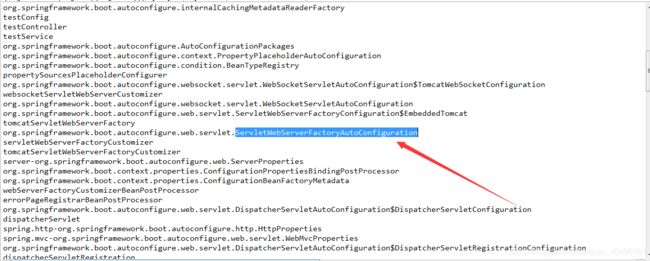
ok,我们点开这个类,跟踪源码
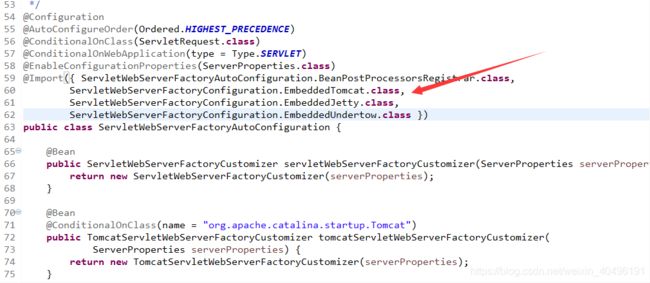
我们知道,springboot其实有三种内容服务器,分别是Tomcat,Jetty,Undertow。默认内置tomcat,。我们继续跟踪EmbeddedTomcat.class
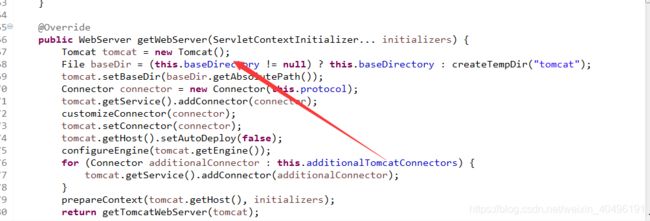
可以看到,其实这里的tomcat服务器是内部通过java代码实现的。到这里,run()方法就算结束了。如果后续想深入了解的可以自己看看源码。其实,run()方法总结起来并不多,大方向无非是配置环境参数,引入注解刷新上下文。其他的一些捕获异常、计时操作都是非重点操作。
三. springboot总结
3.1 springboot原理
包装spring核心注解,使用springmvc无xml进行启动,通过自定义starter和maven依赖简化开发代码,开发者能够快速整合第三方框架,通过java语言内嵌入tomcat
3.2 springboot启动流程
--------------------------------创建springbootApplication对象---------------------------------------------
1. 创建springbootApplication对象springboot容器初始化操作
2. 获取当前应用的启动类型。
注1:通过判断当前classpath是否加载servlet类,返回servlet web启动方式。
注2:webApplicationType三种类型:
1.reactive:响应式启动(spring5新特性)
2.none:即不嵌入web容器启动(springboot放在外部服务器运行 )
3.servlet:基于web容器进行启动
3. 读取springboot下的META-INFO/spring.factories文件,获取对应的ApplicationContextInitializer装配到集合
4. 读取springboot下的META-INFO/spring.factories文件,获取对应的ApplicationListener装配到集合
5. mainApplicationClass,获取当前运行的主函数
6.
------------------调用springbootApplication对象的run方法,实现启动,返回当前容器的上下文----------------------------------------------
7. 调用run方法启动
8. StopWatch stopWatch = new StopWatch(),记录项目启动时间
9. getRunListeners,读取META-INF/spring.factores,将SpringApplicationRunListeners类型存到集合中
10. listeners.starting();循环调用starting方法
11. prepareEnvironment(listeners, applicationArguments);将配置文件读取到容器中
读取多数据源:classpath:/,classpath:/config/,file:./,file:./config/底下。其中classpath是读取编译后的,file是读取编译前的
支持yml,yaml,xml,properties
12. Banner printedBanner = printBanner(environment);开始打印banner图,就是sprongboot启动最开头的图案
13. 初始化AnnotationConfigServletWebServerApplicationContext对象
14. 刷新上下文,调用注解,refreshContext(context);
15. 创建tomcat
16. 加载springmvc
17. 刷新后的方法,空方法,给用户自定义重写afterRefresh()
18. stopWatch.stop();结束计时
19. 使用广播和回调机制告诉监听者springboot容器已经启动化成功,listeners.started(context);
20. 使用广播和回调机制告诉监听者springboot容器已经启动化成功,listeners.started(context);
21. 返回上下文
注:该原理、流程由每特教育&&蚂蚁课堂余老师总结!

